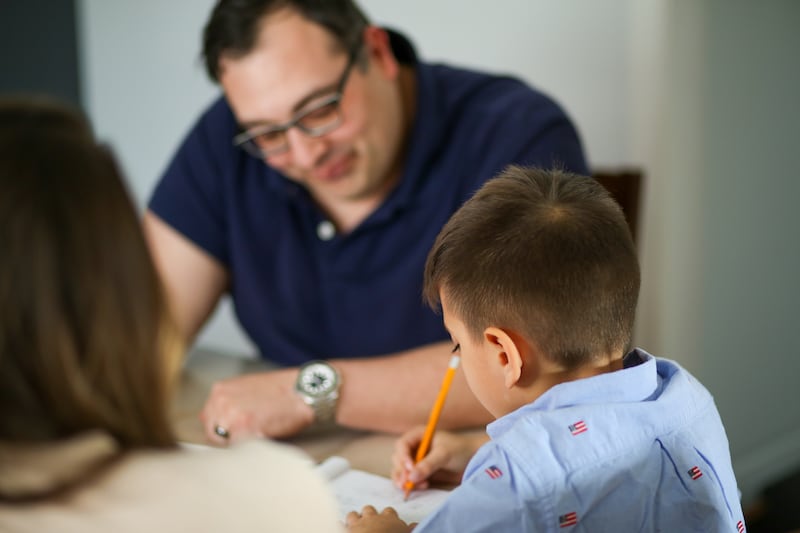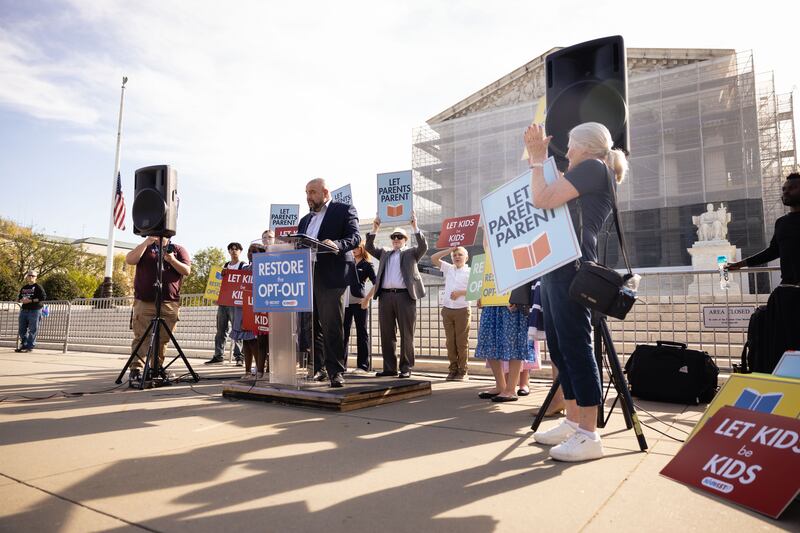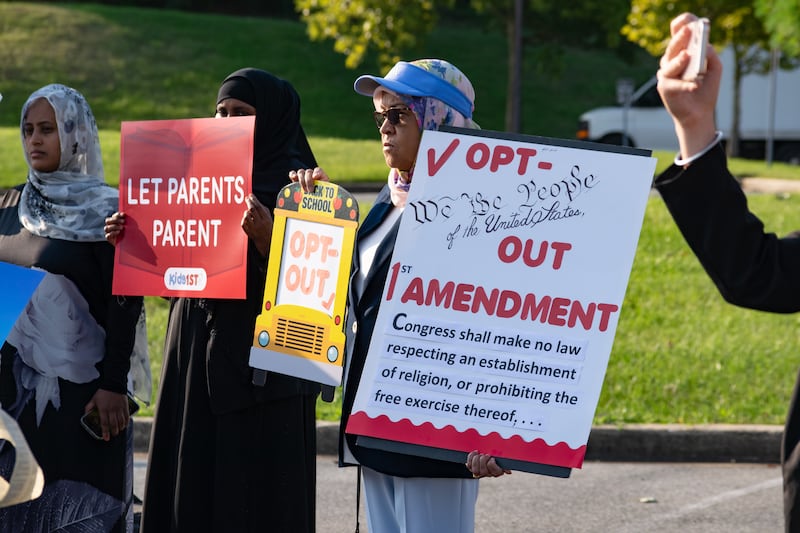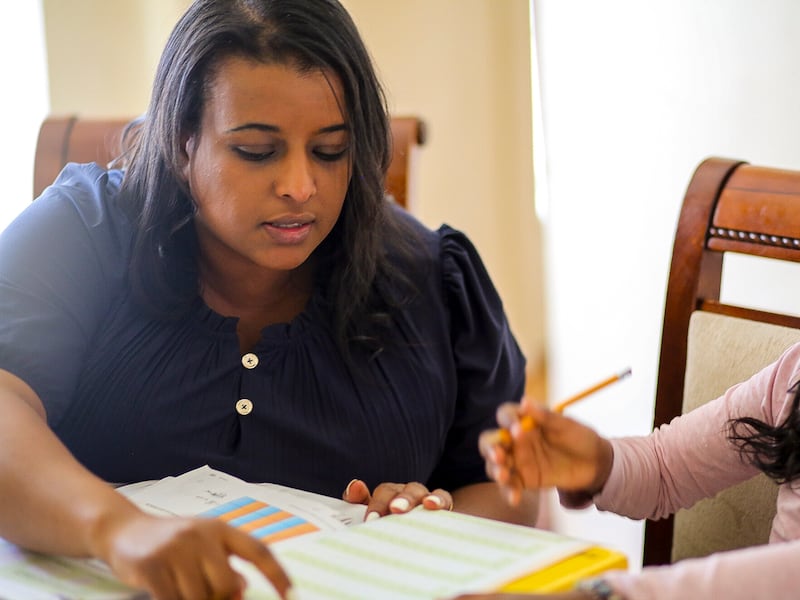Billy Moges had never considered homeschooling until 2022. That year, she decided she could no longer send her daughter to Montgomery County public schools without compromising her Christian values.
For more than a decade, the Maryland school district had allowed parents to opt their children out of elementary school lessons that featured storybooks with LGBTQ+ characters and themes. But in 2022, the books were formally introduced into the K–5 english language arts curriculum, and the following year, the board of education eliminated that opt-out option.
Moges, who holds biblical stances on marriage and sexuality, felt that the new policy left her with no choice. Although homeschooling her three children seemed intimidating, she said “it was the journey we were willing to take as Christians that we will never compromise our faith for education.”
Over the next three years, Moges, who is the director of parent group Kids First, became one of the most active voices in a coalition of religious parents — Muslim, Catholic, Orthodox Christian and others — who sued the Montgomery County Board of Education in a Supreme Court case that would become Mahmoud v. Taylor.
She spoke at school board meetings, joined protests and appeared on television, arguing that the First Amendment protects a parent’s right to guide their children’s moral and religious formation.
On June 27, Moges and other religious parents celebrated a victory when the Supreme Court sided with them.
In a 6–3 decision authored by Justice Samuel Alito, the court ruled that Montgomery County violated the parents’ free exercise rights by requiring young children to attend lessons that conflicted with their families’ religious beliefs, without giving parents notice or the ability to opt out.
“The books are unmistakably normative,” Alito wrote. “They are designed to present certain values and beliefs as things to be celebrated, and certain contrary values and beliefs as things to be rejected.”
But the school officials thought otherwise. They viewed the Supreme Court’s ruling as a setback in inclusion that opened the door for future opt-outs from other lessons on evolution and civil rights. In a joint statement, the school board and district said the decision “complicates our work creating a welcoming, inclusive and equitable school system. It also sends a chilling message to many valued members of our diverse community.”
County council president Kate Stewart called the ruling “deeply disappointing” and warned that it undermines efforts to create a culture where “everyone is seen and valued as their true and authentic selves.”
Parents responsible for their children
For families who pulled their children from the schools over the policy, the decision is already prompting change. In group chats, like-minded parents have been circulating sample emails and opt-out forms, preparing to reenroll their kids in the fall.

“Parents aren’t waiting for Montgomery County or for the attorneys to tell them what to do,” said Ismail Royer, director of Islam and religious freedom at the Religious Freedom Institute, who’s been involved in the opt-out controversy since spring of 2023. “They’re taking the initiative in their hands.”
Moges, however, isn’t ready to reenroll her kids. They will attend a Christian private school next year, she said. Before reenrolling them in public school, she would like to hear a clear commitment from school officials that they’ll “treat parents as partners.”
Montgomery County Board of Education said it’s working “to determine next steps in order to meet the expectations of the Court’s ruling and remain true to our shared values of learning, relationships, respect, excellence, and equity,” a spokesperson told the Deseret News in an email, adding that parents would receive more information before the start of the school year.
“We want transparency, the understanding and partnership to be restored,” Moges said. “And leave the legalistic issues aside and really having a heart to heart, as people. We want to continue what’s been there for years.”
How did we get here?
Parents who objected to the books on sexuality and gender identity in elementary schools were initially able to opt their children out of these lessons. But in 2023, the district reversed that policy, saying no student would be excused based on religious beliefs, claiming the opt-outs were “unworkable” and caused teaching disruptions.
In response, a group of religious parents sued. They didn’t ask for the books to be removed or for the curriculum to be changed, only that their children be excused from lessons that conflicted with their beliefs.
In “Uncle Bobby’s Wedding,” for instance, a girl named Chloe overcomes her disappointment about her uncle’s same-sex marriage and eventually comes to celebrate the union and more connection. Another book “Born Ready” follows a transgender child asserting his identity.
A district court and the U.S. Court of Appeals for the 4th Circuit both denied their request for a preliminary injunction, but the Supreme Court agreed to hear the case.
Writing for the majority, Alito emphasized that the case turned on the combination of three factors: the moral framing of the books, the very young age of the students, and the district’s refusal to allow any form of opt-out. Together, the court found, those factors created a “substantial burden” on parents’ religious freedom. This was not passive exposure to diversity, the opinion said, but a form of compulsion.
Meanwhile, other school districts in the country have experienced similar tensions and were able to resolve them without courts. When a group of Somali Muslim parents in St. Louis Park, Minnesota, a suburb of Minneapolis, threatened to sue the district in 2023, the district granted parents permission to opt their kids out of the LGBTQ-themed books.
The ruling clarified that schools must now offer notice and accommodation when teaching material that conflicts with a family’s religious beliefs — particularly when it’s directed at very young children.
“We never asked to change the curriculum,” said Wael Elkoshairi, a Muslim father who has been homeschooling his daughter, a rising fifth grader. “All we asked for is an accommodation.”

By the time the case reached the Supreme Court, many parents had already adapted: Some withdrew their kids from public school, others made ad-hoc arrangements with sympathetic teachers.
But these workarounds, combined with failed attempts to elect proponents of opt-outs to the school board, left parents “demoralized” and drained momentum from the broader movement, according to Royer.
“I think on the one hand, there is a lot of joy and vindication,” Royer said about the mood after the Supreme Court decision. “But on the other hand, it’s a little bit anticlimactic because, in a lot of cases like this, it ends up being that the process is the punishment itself.”
Inclusion or indoctrination?
Where the county, its supporters and LGBTQ advocacy groups touted inclusion and diversity through reading the books, religious parents — and eventually the Supreme Court’s majority — believed the curriculum went beyond exposing students to diverse viewpoints, but instead actively promoted views on gender and sexuality while discouraging dissenting views.
“Framing the compulsory rewriting of norms as merely learning about existence — about the existence of LGBTQ people — what they did is make people very suspicious of the very term ‘inclusion,’” Royer, of the Religious Freedom Institute, said in an interview.
On the other side, opt-out critics argued that simply reading them doesn’t impose values on students but educates them about the diversity of the world around them.
“This is people’s lives. These are regular folks living their regular lives,” Phillip Westry of Free State Justice told CBS. For many protesting opt-outs, even a student quietly leaving the room sent a troubling message.
“We would never tolerate it with anything else,” said Marc Nobleman at a protest he attended in April. “You wouldn’t allow kids to walk out because you’re talking about Black people or Jewish people or Muslim people.”
But defenders of opt-outs say that leaving the classroom in this case is not a sign of disrespect but instead living according to one’s sincere religious beliefs.
For parents like Billy Moges, the issue was deeply personal and spiritual. She believes the Christian teachings on marriage and gender are nonnegotiable and so is her responsibility to pass those teachings on to her children.
“This is more than just a journey for us,” said Moges, who grew up attending Montgomery public schools and was among the children who opted out of class discussions of sexual nature. “This is eternity.”
Wael Elkoshairi shares a similar view.
“We believe in traditional marriage between a man and a woman — but we also believe this is a pluralistic society, and not everybody is Muslim,” he told me. While opt-outs were still allowed, his daughter was one of 14 students out of over 170 in her elementary school who were sent to the media room during certain classes.
“You live as you please, and we have no reason to interfere with your life,” he said. “We have no hate for the LGBTQ community.”
Some parents stuck with the public school despite inability to opt out.
“I like public schools so they can mix with everybody,” said Shaykh El Hadji Sall, another Muslim parent and religious leader in Maryland, who enrolled his children in private school before returning them to public school. “We respect their values, and they should respect ours as well.”
Royer suggested that moral teachings in public schools should focus on more characteristics that are shared across all beliefs, like treating everyone with generosity, respect, kindness, courage and curiosity as well as civic values and being a good citizen.
“Those are values and virtues that everyone can agree upon,” he said.
Writing about the case, religious liberty scholar Asma Uddin argued that the Supreme Court did not just find exposure to the LGBTQ themes unconstitutional but rather that the combination of moral messaging, institutional reinforcement and lack of opt-out rights for very young children created a form of compulsion that burdened parents’ religious freedom.
“Opt-out policies, clear notice, and open dialogue with families aren’t threats to diversity — they’re how pluralism works in practice,” Uddin wrote. She concluded that “protecting diversity means more than celebrating many voices — it means leaving room for meaningful dissent.”
Beyond the curriculum, the case highlighted a deeper debate about the roles of schools and parents in shaping children’s moral development. “It’s not simply that we disagree with what was being taught,” Royer said. “It’s the general principle of what is the role of schools and educators.”

Restoring trust
For Moges, the legal battle left scars on the community she’s loved since she was a child. “We were all neighbors, we talked to each other, but now there’s such distress and such a gap that we’ve become two different groups. And we want that to be restored.”
She hopes that things will get resolved before the beginning of the school year. Elkoshairi said he’s waiting to see how local officials respond before recommitting to the schools for his daughter. “We’re on standby,” he said.
Although the Supreme Court issued a ruling, it won’t become final until later this month, when the court sends a procedural mandate back to the 4th Circuit. That court is then expected to instruct the district court to issue a preliminary injunction requiring Montgomery County schools to restore opt-outs.
“The Supreme Court was very clear that the district court should order the school district to opt parents out from the books,” said Eric Baxter, an attorney at Becket who represented the parents. “We think that language pretty much dictates what the district court is going to have to do.”
The breadth of the ruling is important, he noted, because it gives parents more power to opt their children out of school lessons or policies that conflict with their religious beliefs.
Still, Moges is eager to restore the relationship with the public schools and its teachers. She wants to volunteer and help.
“I’m still wanting that partnership, not just for my kids, but kids of the county and the neighborhood,” she said. “That’s how you build a community.”


